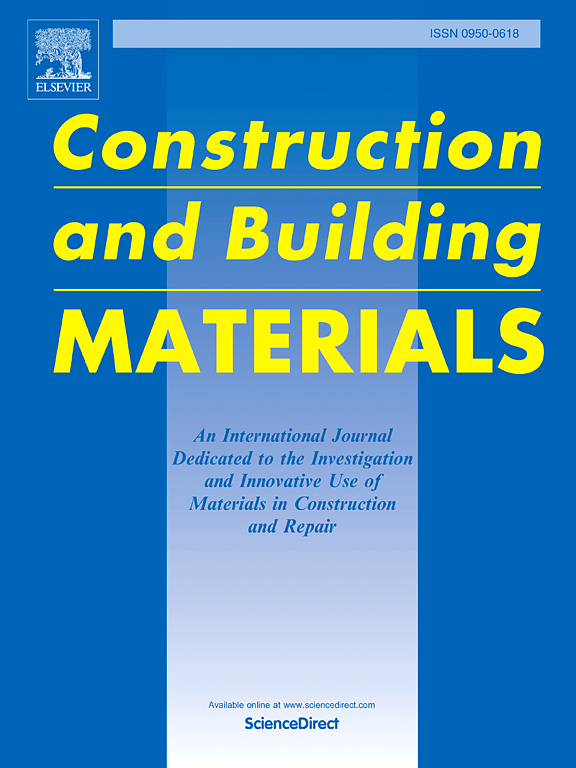Spheres prepared by air-quenching of the blast furnace titanium slag melts and its secondary thermal treatment
IF 8
1区 工程技术
Q1 CONSTRUCTION & BUILDING TECHNOLOGY
引用次数: 0
Abstract
Considerable blast furnace titanium slags (BFTS) are generated during the V-Ti magnetite smelting process, which had been low-value utilized as aggregates in construction and building areas. In this study, an air-quenching process was proposed to treat BFTS melts directly to obtain spherical BFTS particles. The obtained BFTS spheres (ATS) were sieved into 16–30 mesh (S1), 40–70 mesh (S2) and 70–140 mesh (S3). The morphological parameters (including roundness and sphericity), mineral and chemical compositions of all ATSs were determined by image analysis, scanning emission microscopes (SEM), X-ray fluorescence spectrometry (XRF), and X-ray diffraction (XRD), etc. While their properties were also measured experimentally. It is concluded that all ATSs have a smooth spherical shape with relatively higher sphericity and roundness. ATSs exhibit a better close packing and lower water absorptions as compared with raw BFTS. ATS S3 showed relatively lower acid solubility and excellent crushing resistance as compared with those of ATS S1 and ATS S2. A secondary thermal treatment method is proposed to further improve the acid solubility and crushing resistance of ATSs. Glass phases in ATSs are transformed into crystalline phases, thus improved the acid solubility and crushing resistance of the ATS samples, excluding the crushing resistance of ATS S3. It is expected that the preparation of ATS through air-quenching and the consequent secondary thermal treatment was one of the most proper way in the treatment and high-value utilization of BFTS. And the obtained ATS can be used as a special and functional high-performance aggregate/filler in the construction field or others.
高炉钛渣熔体气淬制备球体及其二次热处理
钒钛磁铁矿冶炼过程中产生了大量的高炉钛渣(BFTS),这些渣作为集料在建筑和建筑领域的低价值利用。在本研究中,提出了一种空气淬火工艺,直接处理BFTS熔体,以获得球形BFTS颗粒。所得BFTS球(ATS)筛分为16-30目(S1)、40-70目(S2)和70-140目(S3)。采用图像分析、扫描发射显微镜(SEM)、x射线荧光光谱法(XRF)和x射线衍射仪(XRD)等方法测定了所有ats的形貌参数(包括圆度和球度)、矿物和化学成分。同时它们的性质也被实验测量了。结果表明,所有ats均为光滑的球形,球度和圆度均较高。与原料BFTS相比,ats具有更好的密实性和更低的吸水率。与ATS S1和ATS S2相比,ATS S3具有较低的酸溶解度和优异的抗破碎性。为了进一步提高ATSs的酸溶性和抗破碎性,提出了一种二次热处理方法。ATS中的玻璃相转变为结晶相,从而提高了ATS样品的酸溶性和抗破碎性,排除了ATS S3的抗破碎性。预计气淬法制备ATS并进行二次热处理是处理和高价值利用BFTS的最佳途径之一。所制得的ATS可作为一种特殊的功能性高性能骨料/填料应用于建筑领域或其他领域。
本文章由计算机程序翻译,如有差异,请以英文原文为准。
求助全文
约1分钟内获得全文
求助全文
来源期刊

Construction and Building Materials
工程技术-材料科学:综合
CiteScore
13.80
自引率
21.60%
发文量
3632
审稿时长
82 days
期刊介绍:
Construction and Building Materials offers an international platform for sharing innovative and original research and development in the realm of construction and building materials, along with their practical applications in new projects and repair practices. The journal publishes a diverse array of pioneering research and application papers, detailing laboratory investigations and, to a limited extent, numerical analyses or reports on full-scale projects. Multi-part papers are discouraged.
Additionally, Construction and Building Materials features comprehensive case studies and insightful review articles that contribute to new insights in the field. Our focus is on papers related to construction materials, excluding those on structural engineering, geotechnics, and unbound highway layers. Covered materials and technologies encompass cement, concrete reinforcement, bricks and mortars, additives, corrosion technology, ceramics, timber, steel, polymers, glass fibers, recycled materials, bamboo, rammed earth, non-conventional building materials, bituminous materials, and applications in railway materials.
 求助内容:
求助内容: 应助结果提醒方式:
应助结果提醒方式:


